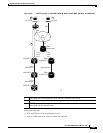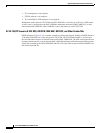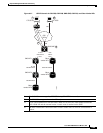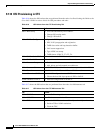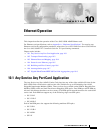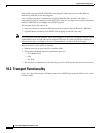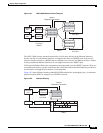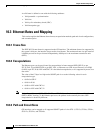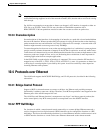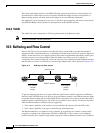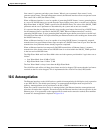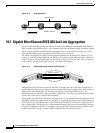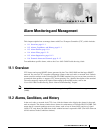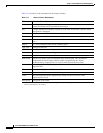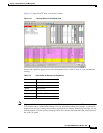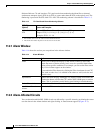
10-5
Cisco ONS 15600 Reference Manual, R7.2
Chapter 10 Ethernet Operation
10.3.4 Oversubscription
Note
Mapping depends on the particular concatenation being supported on the card. It also depends on the
concatenation being supported on all of the network elements (NEs) that the end-to-end circuit is being
built through.
For full line-rate mapping to ensure that no frames are dropped, a GE interface is mapped to either an
STS-24c or an STS-48c. At the STS-24c rate, the effects of bandwidth expansion due to
HDLC/GFP/ITU X.86 encapsulations need to be taken into account to ensure no packet loss.
10.3.4 Oversubscription
Oversubscription of data interfaces is the mapping of an interface to a path with a lower bandwidth than
the rate of the interface. When oversubscribing, the operator is relying on the fact that on data interfaces,
packet transmission rates and utilization is not always 100 percent. For example, a customer with a GE
interface might transmit at an average rate of only 100 Mbps.
To ensure that packet loss does not occur or that any ensuing packet loss is minimized, system engineers
need to carefully estimate the amount of memory in the NE that is required to sustain any traffic bursts.
Traffic bursts are characterized by several different models that take into account such parameters as the
mean rate, peak rates, length of burst, and so on. Performing these calculations is more important in
switching applications than in transport applications.
In the ONS 15600, oversubscription of interfaces is supported. This occurs when the GE interface is
mapped to any of the STS-1, STS-3, STS-6, STS-9, and STS-12 (c) rates. No guarantees on frame loss
or delay due to oversubscription is provided by the system. Actual loss and delay values depend on
incoming Ethernet traffic patterns.
10.4 Protocols over Ethernet
The ASAP card supports the BCP, PPP Half Bridge, and VLAN protocols, described in the following
subsections.
10.4.1 Bridge Control Protocol
Support of BCP is relevant between two routers or bridges. An Ethernet card providing transport
functionality is neither a router nor a bridge. Therefore, even BCP encapsulation is not supported on the
Ethernet ports of the ASAP transport line card.
The ASAP line card Ethernet function is transparent to any Layer 2 and above protocol packets (the
entire control plane). Any BCP control packets are transported out to the SONET interface.
10.4.2 PPP Half Bridge
For situations in which a routed network needs connectivity to a remote bridged Ethernet network, a
serial or integrated services digital network (ISDN) interface can be configured to function as a PPP
half-bridge. The line to the remote bridge functions as a virtual Ethernet interface, and the router's serial
or ISDN interface functions as a node on the same Ethernet subnetwork as the remote network.



